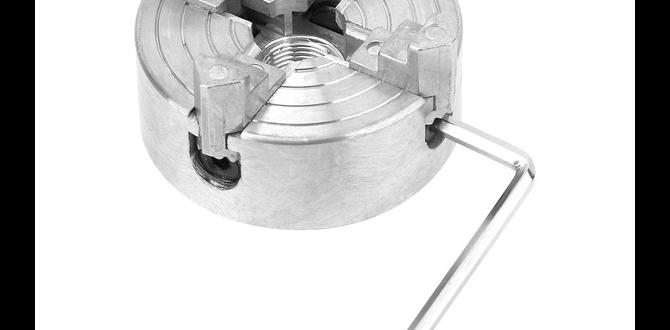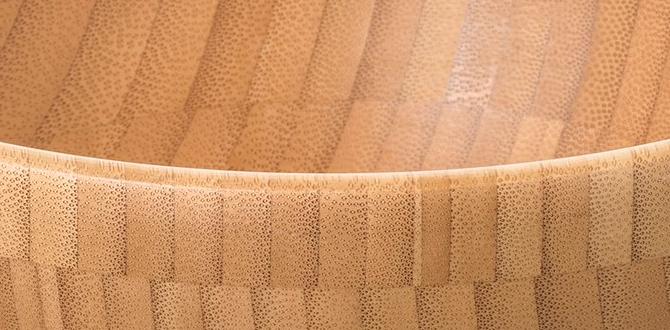Cut bronze like a pro with a 1/8-inch carbide end mill! This guide proves that with the right technique, achieving clean, precise bronze cuts is totally achievable for beginners. We’ll show you safe, effective methods to get impressive results without the frustration.
Working with bronze can be tricky for newcomers. You want that perfect cut, but sometimes you end up with a rough edge or a damaged tool. It’s easy to feel intimidated, especially when starting out with specialized tools like a 1/8-inch carbide end mill. But don’t worry! Many beginners face this. This guide is designed specifically for you, breaking down every step to make cutting bronze with this specific tool simple and successful. We’ll cover everything you need to know, from choosing the right mill to the best cutting strategies, ensuring you get smooth, clean results every time.
Carbide End Mill 1/8 Inch: Your Key to Proven Bronze Cutting
When you’re looking to machine bronze, having the right cutting tool is crucial. The 1/8-inch carbide end mill, especially models designed for dry cutting and often found with a 1/4-inch shank for extra reach, is a popular choice. Its toughness and ability to hold a sharp edge make it excellent for metals like bronze. Let’s dive into why this specific tool is such a good fit for your projects.
Why a 1/8-Inch Carbide End Mill for Bronze?
Bronze is denser and harder than many plastics or softer metals. While other end mills might wear down quickly or struggle to create a clean finish, carbide offers superior hardness and heat resistance. This means it can power through bronze with less wear and tear, giving you more consistent results. The 1/8-inch size is perfect for detailed work, small features, or when you need to create narrow slots or pockets. Many of these mills are designed for dry cutting, which simplifies your setup as you don’t need coolant. This is a huge plus for home workshops and beginners learning the ropes.
Key features to look for:
- Material: Solid carbide is your go-to for its hardness and heat resistance.
- Flute Count: For bronze, 2-flute or 4-flute end mills are common. 2-flute mills often perform better in softer metals like bronze as they provide better chip clearance.
- Coating: While not always necessary for dry cutting bronze, some coatings can further enhance performance and tool life.
- End Type: Square end mills are general-purpose and most common.
- Shank Size: You’ll often see 1/8-inch cutters on a 1/4-inch shank. This larger shank provides more rigidity, which is important when cutting tougher materials like bronze. Extra-long shanks can be helpful for reaching into deeper pockets or parts.
Understanding Your 1/8-Inch Carbide End Mill
Before we start cutting, let’s get familiar with what makes these tools tick. The 1/8-inch size refers to the diameter of the cutting head, and the 1/4-inch shank is the part that fits into your milling machine’s collet or tool holder. The flutes are the spiral grooves that do the cutting and help evacuate chips.
Carbide vs. High-Speed Steel (HSS)
You might wonder why carbide is preferred over High-Speed Steel (HSS) for bronze. HSS is more flexible and less brittle, which can be good, but carbide is significantly harder and can withstand higher cutting speeds and temperatures. For a material like bronze, carbide’s hardness translates to a cleaner cut, longer tool life, and the ability to maintain precision. Think of it this way: carbide is like a super-sharp, hard knife that slices through materials cleanly, while HSS might be more like a slightly less sharp knife that can sometimes drag or tear.
The “Dry Cutting” Advantage
Many 1/8-inch carbide end mills marketed for non-ferrous metals like bronze are designed for dry cutting. This means they work effectively without the need for liquid coolant. This is great because:
- Simpler Setup: No messy coolant systems to manage.
- Cleaner Workspace: Less oil or water spray around your machine.
- Cost-Effective: Saves money on coolant.
- Material Integrity: Sometimes, dry cutting can prevent certain materials from discoloring or reacting with coolant.
Even when dry cutting, proper chip evacuation is key to preventing heat buildup. We’ll discuss this more when we get to machining techniques.
Choosing the Right 1/8-Inch Carbide End Mill for Bronze
Not all 1/8-inch carbide end mills are created equal, especially when you’re targeting bronze. The specific design of the mill plays a big role in how well it cuts. Here’s what to look for:
End Mill Specifications for Bronze Machining:
When browsing for your end mill, keep an eye on these details:
- Non-Ferrous or Aluminum Specific: Mills designed for aluminum or general non-ferrous metals are often excellent choices for bronze. They usually feature polished flutes and optimized flute geometry for softer, gummy metals.
- Coating: A bright, polished finish or a specific coating like ZrN (Zirconium Nitride) can help prevent material buildup and improve surface finish.
- Helix Angle: A steeper helix angle can help pull chips out of the cut more effectively, which is beneficial for bronze.
- Number of Flutes: As mentioned, 2-flute end mills are generally preferred for bronze. They offer fewer cutting edges, which can reduce the risk of chatter and improve chip evacuation. Check out resources like a guide to end mill selection to see how different flute counts are used.
Example Table: End Mill Types for Bronze
| End Mill Type | Pros for Bronze | Cons for Bronze | Ideal Use Case |
|---|---|---|---|
| 2-Flute, Uncoated Carbide | Good chip clearance, cost-effective. | Can build up heat faster than coated. | General-purpose cutting, shallow pockets. |
| 2-Flute, ZrN Coated Carbide | Excellent chip clearance, reduced buildup, good tool life. | Slightly more expensive. | Consistent cutting, detailed work, longer runs. |
| 4-Flute, Polished Carbide | Smoother finish, can handle higher feed rates (sometimes). | Can clog more easily, less chip clearance than 2-flute. | Finishing passes, lighter cuts where finish is paramount. |
For beginners, a 2-flute, uncoated or ZrN-coated carbide end mill with a polished finish is often the sweet spot for cutting bronze. It balances performance, chip evacuation, and cost.
Essential Tools and Safety Precautions
Before you even think about turning on your milling machine, let’s make sure you have the right gear and know the safety rules. Safety is non-negotiable in any workshop, especially when working with rotating machinery and sharp tools.
Your Milling Setup Checklist:
- Milling Machine: A benchtop CNC or manual mill that can hold a 1/4-inch shank.
- Collet and Collet Wrench: To securely hold the end mill in your machine’s spindle. Make sure the collet size matches your end mill shank (e.g., a 1/4-inch collet for a 1/4-inch shank).
- 1/8-Inch Carbide End Mill: Specifically chosen for non-ferrous metals.
- Bronze Workpiece: Securely clamped to your machine’s table.
- Safety Glasses: Absolutely essential. Wear them at all times.
- Face Shield: Recommended for added protection, especially when cutting.
- Hearing Protection: Milling can be loud.
- Workpiece Clamping: Vise, clamps, or dedicated fixtures to hold your bronze firmly. Ensure nothing can come loose.
- Deburring Tool: For cleaning up edges after machining.
- Brush: A brass or nylon brush for cleaning chips.
Safety First: Always!
Working with metal can be hazardous if you’re not careful. Here are critical safety practices:
- Eye Protection: Wear ANSI-approved safety glasses with side shields at all times. A face shield offers even better protection.
- Secure Your Workpiece: Loosely clamped material is a recipe for disaster. Invest time in proper fixturing.
- Secure Your Tool: Ensure the end mill is firmly seated in the collet and the collet is properly tightened.
- Clear the Area: Remove any unnecessary tools, materials, or clutter from around your machine.
- Chip Management: Chips can be sharp and hot. Never try to clear them by hand while the machine is on or the spindle is coasting down. Use a brush or compressed air (cautiously).
- Slow and Steady: Especially when learning, start with slower spindle speeds and feed rates.
- Never Reach Over a Spinning Spindle: Wait for the spindle to come to a complete stop.
- Know Your Machine: Understand its emergency stop and how to operate it.
- Read Manuals: Refer to your milling machine’s and end mill manufacturer’s instructions. You can find general safety guidelines for machining from organizations like the Occupational Safety and Health Administration (OSHA).
Step-by-Step: Cutting Bronze with a 1/8-Inch Carbide End Mill
Now that you’re prepared, let’s get to the exciting part: making those cuts! We’ll assume you’re using a small benchtop mill. The principles are the same for larger machines, but you’ll adjust speeds and feeds accordingly.
Step 1: Prepare Your Work Area and Machine
Ensure your milling machine is clean and ready. Check that the power cord is safe and the emergency stop is accessible. Clear away any debris. Mount your workpiece securely in a vise or with clamps. Double-check that the workpiece won’t move during machining.
Step 2: Install the End Mill
Select the correct collet for your 1/4-inch shank end mill. Insert the end mill into the collet, ensuring it’s seated fully. Insert the collet into your machine’s spindle and tighten it according to your machine’s instructions. Make sure the end mill is centered and doesn’t wobble.
Step 3: Set Up Your Z-Axis Zero
This is a crucial step for controlling your depth of cut. You can use a Z-probe, a dial indicator held against the end mill’s tip, or simply bring the end mill down until it lightly touches the top surface of your workpiece. Once it touches, set your Z-axis DRO (Digital Readout) or CNC controller to zero. Be extremely gentle when making contact.
Step 4: Program or Manually Set Your Cutting Path
If you’re using a CNC, you’ll program your toolpath for pockets, slots, or contours. For manual milling, you’ll be moving the machine’s axes.
- For a slot: You’ll likely move the machine’s X or Y axis while the end mill spins and is at the correct Z depth.
- For a pocket: You’ll need to move in a pattern (like a spiral or back-and-forth) to clear the entire area.
Step 5: Determine Speeds and Feeds (A Beginner’s Approach)
This is often the most daunting part for beginners. For bronze with a 1/8-inch carbide end mill, we’ll use conservative, beginner-friendly settings. These are starting points, and you might need to adjust.
Spindle Speed (RPM): For a 1/8-inch carbide end mill in bronze, a good starting range is typically between 5,000 and 10,000 RPM. Let’s aim for the lower end to be safe, say 6,000 RPM.
Feed Rate (IPM or mm/min): This is how fast the tool moves through the material. For a 1/8-inch mill, a conservative feed rate might be around 10-20 inches per minute (IPM). So, let’s start with 15 IPM.
Depth of Cut (DOC): How deep you want to cut in a single pass. For a 1/8-inch end mill, take small bites. A good starting DOC is 0.030 to 0.050 inches (about 0.75mm to 1.25mm). Avoid trying to cut too deep at once, as this puts a lot of stress on the tool and machine.
As a reference, manufacturers often provide charts. For example, a tool like the widely available Graham 2-flute end mills designed for aluminum suggest similar RPM and feed rates that work well for bronze in a hobbyist setting. Always check the manufacturer’s recommendations if available!
Step 6: Make Your First Cut
Start the spindle. Once it reaches your target RPM, begin feeding the end mill into the material.
- Plunge (if necessary): If you need to cut into the material from the top (a pocket), do it slowly. Some end mills are “center cutting,” meaning they can plunge straight down. If yours isn’t, you’ll need to ramp into the material. For simplicity, let’s assume a center-cutting end mill or you are slotting without plunging.
- Feed Through Material: Move the end mill at your set feed rate. Listen to the sound of the cut. A smooth, consistent sound is good. A loud squealing or chattering indicates you might be going too fast or too deep.
- Chip Evacuation: Watch the chips. Are they small and fluffy, or large and clumpy? If they’re clumpy, your feed rate might be too high, or you need to clear them more often. For dry cutting, you might need to pause occasionally to brush chips away.
Step 7: Control Depth and Passes
If you need to cut to a specific depth, make a pass, retract the tool (raise it up), and then set your new Z zero at the bottom of your previous cut PLUS the depth of your next pass. For example, if your first pass was 0.040 inches deep, and you want to cut to 0.100 inches total, you’ll move your Z down another 0.060 inches. Then, make the second pass. Repeat until you reach your desired depth.
Step 8: Finishing Touches
Once the main cutting is done, you might want to do a finishing pass. This is a very light cut, often with a slightly higher feed rate and a cleaner path, to achieve a smoother surface finish. After machining, carefully remove the part. Use a deburring tool to smooth any sharp edges left by the end mill. Clean the part with a brush and your preferred cleaning solution.
Advanced Techniques for Bronze Cutting
Once you’re comfortable with the basics, here are a few tricks to improve your results when cutting bronze:
Toolpath Strategies
- Climb Milling vs. Conventional Milling: For most hobbyist applications, especially when hand-feeding a manual mill, conventional milling is safer and less prone to tool breakage. In CNC, climb milling (where the cutter rotates in the same direction as the feed) can provide a better finish and reduce tool pressure. Experiment with caution!
- Spiral Machining (for Pockets): Instead of just going back and forth, move the end mill in a gentle spiral pattern as you clear out a pocket. This can improve chip evacuation and reduce heat.
- Ramping: If your end mill isn’t center-cutting, you can’t plunge straight down. Instead, program or manually move the tool along a shallow angle (ramp) into the material until it’s fully engaged, then proceed with your pocketing.
Chip Management is Key
Bronze can be “gummy,” meaning chips tend to stick together. This can clog flutes, cause overheating, and lead to a poor finish or tool breakage. Even with dry-cutting mills:
- Peck Drilling/Pecking Cycles: For deep holes or pockets, use a pecking cycle if your CNC supports it. This involves plunging slightly, retracting to clear chips, and repeating.
- Air Blast: A small air jet can help blow chips away from the cutting zone.
- Brush Away Chips: When manually milling, pause periodically to gently brush away chips with a brass or nylon brush, even without stopping the spindle completely (but be very careful and keep hands clear!).







